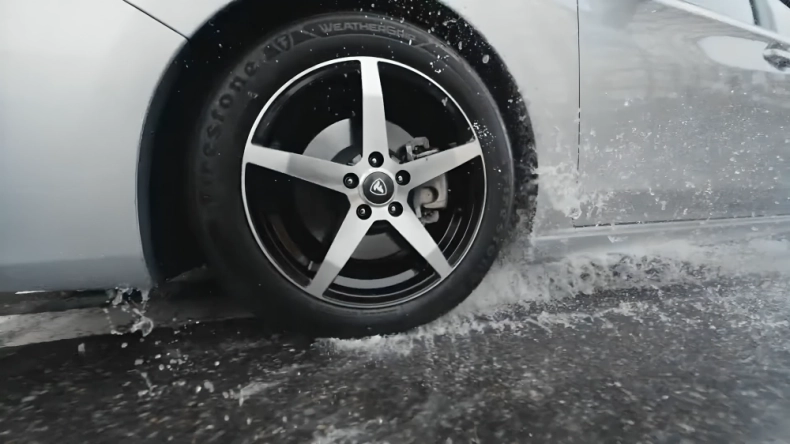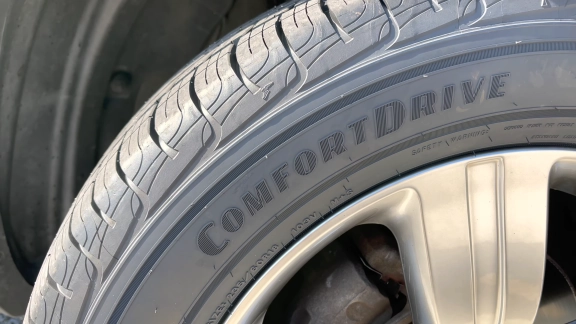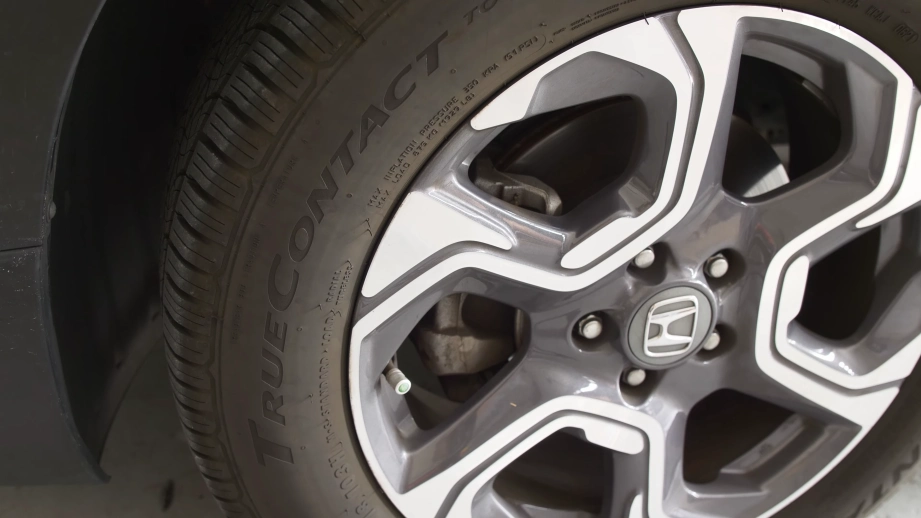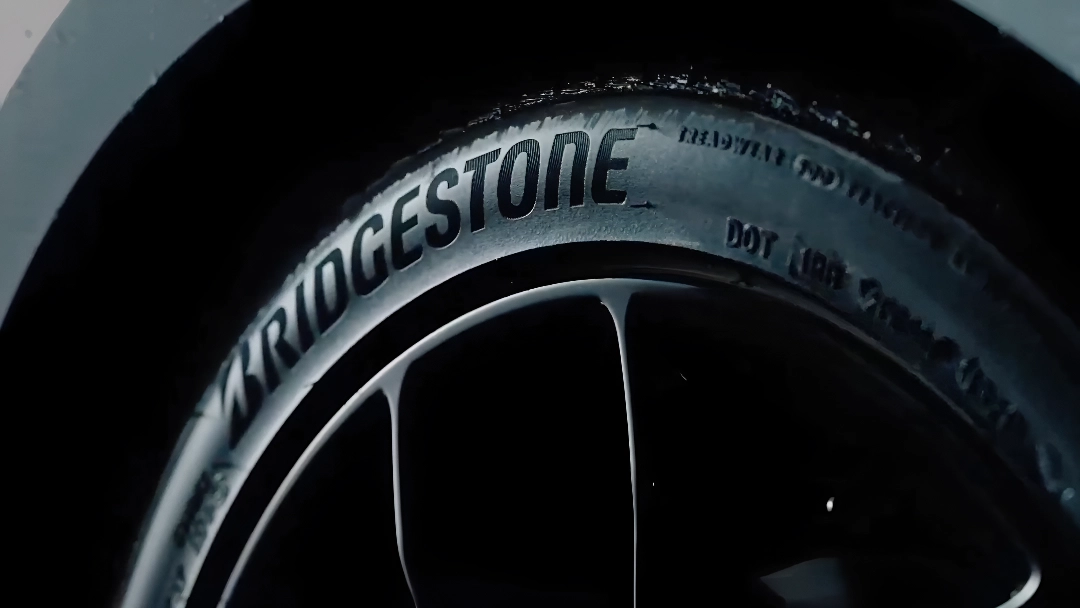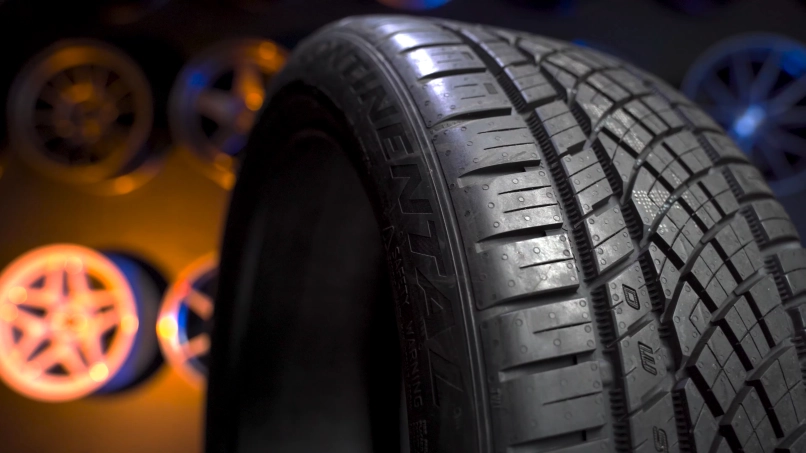
- Built to Help Keep You in Control, No Matter The Weather
- Confident Wet Performance Year Round
- Long-Lasting Performance with a 65,000 Mile Limited Mileage Warranty
- 3 Peak Mountain Snowflake Certified
Forget everything you thought you knew about the relationship between price and performance in the tire world. The Firestone WeatherGrip doesn’t just challenge conventional wisdom — it demolishes it entirely, delivering the kind of jaw-dropping weather performance that makes you question why anyone pays premium prices for lesser capability. This isn’t about settling for “good enough” — this is about discovering that the most capable all-weather tire on your block might just be the most affordable one too. While other brands whisper promises about weather performance, the WeatherGrip roars with confidence, transforming white-knuckle weather encounters into smooth, controlled experiences that leave you wondering how you ever drove without it.
What you’re about to learn will forever change how you think about the relationship between price and tire performance.
Brief History
Firestone’s tire manufacturing heritage spans over a century, established in 1900 by Harvey Firestone with a commitment to innovation and reliability. As one of America’s most recognizable tire brands, Firestone built its reputation on creating dependable tires for everyday drivers, from the early days of automotive transportation through modern highway travel. The company’s focus has always been on delivering solid performance at accessible price points.
The WeatherGrip represents Firestone’s modern approach to all-season tire design, introduced in recent years as part of their commitment to advanced weather technology for mainstream consumers. Developed with input from Bridgestone’s global tire technology division (Firestone’s parent company since 1988), this tire was created to bring sophisticated weather performance to drivers who previously had to choose between premium features and budget constraints.
It’s been embraced by families, commuters, and value-conscious drivers who need dependable transportation in all conditions. The WeatherGrip has found its way onto everything from compact cars to mid-size SUVs, proving that advanced weather capability doesn’t require premium pricing. Its success reflects Firestone’s understanding that most drivers need reliable, safe transportation more than ultimate performance numbers.
But enough history lessons — let’s pop the hood on this weather warrior and discover the surprisingly sophisticated tech hiding beneath that humble price tag.
Technologies and Construction
The Firestone WeatherGrip doesn’t just promise all-season capability — it delivers it through thoughtful engineering, proven materials, and practical design solutions.
Firestone engineered this tire as an accessible answer for everyday drivers, combining effective technologies, reliable construction, and time-tested engineering principles into a package that prioritizes real-world safety and value.
Advanced Weather Command Technology
At the core of the WeatherGrip lies Firestone’s Weather Command Technology, a comprehensive approach to all-season performance that focuses on the conditions most drivers actually encounter. This isn’t just a marketing term — it represents a systematic design philosophy that prioritizes wet and light snow traction where most weather-related accidents occur.
The technology centers on a specialized compound that maintains flexibility across a wide temperature range while providing the grip characteristics needed for confident driving in challenging conditions.
Unlike compounds that optimize for one specific condition, Weather Command Technology focuses on the transitional weather states — wet roads, light snow, slush, and temperature fluctuations — where drivers need the most help.
The compound activates predictably across temperature ranges, providing consistent performance whether you’re dealing with an unexpected rain shower during your morning commute or navigating through a light snowfall on the way home. This reliability is what allows the WeatherGrip to deliver confidence-inspiring performance for drivers who can’t predict what weather they’ll encounter.
Three-Peak Mountain Snowflake Certification
One of the WeatherGrip’s most significant achievements is earning the Three-Peak Mountain Snowflake (3PMSF) symbol, certifying it for severe snow service. This certification isn’t easily obtained — it requires meeting or exceeding specific traction standards in snow testing, demonstrating that the tire can handle serious winter conditions.
For a tire in the WeatherGrip’s price category, this certification represents exceptional value. Many premium tires don’t achieve this rating, making the WeatherGrip’s winter capability particularly impressive.
The certification process involves rigorous testing on snow-covered surfaces, measuring traction during acceleration, braking, and cornering in conditions that challenge even dedicated winter tires.
This certification means drivers can confidently tackle snow-covered roads, icy patches, and slush conditions without worrying about inadequate traction. For enthusiasts living in areas with unpredictable winter weather, this capability provides peace of mind that extends far beyond the tire’s modest price point.
Optimized Tread Architecture
The WeatherGrip employs an intelligent tread design that balances multiple performance priorities within practical constraints. The asymmetric pattern incorporates different zones optimized for specific conditions — outer shoulders for dry handling, intermediate areas for wet traction, and inner portions for snow and slush performance.
The tread blocks are sized and shaped to provide adequate grip without excessive rolling resistance, helping maintain fuel economy while delivering the traction drivers need. The pattern includes strategically placed sipes — thin slits in the tread blocks — that create additional biting edges for wet and snow traction while maintaining block stability for dry handling.
Firestone’s engineers also incorporated noise reduction considerations into the tread design, using varied block spacing and shapes to minimize road noise and create a more comfortable driving experience. This attention to refinement details helps the WeatherGrip deliver a premium feel despite its accessible pricing.
Robust Internal Construction
Beneath its weather-focused tread, the WeatherGrip features solid construction designed for durability and consistent performance. The tire uses twin steel belts reinforced with polyester cord body plies, creating a structure that balances strength, flexibility, and longevity within cost-effective manufacturing parameters.
The sidewall construction incorporates materials chosen for their ability to maintain consistent performance across temperature ranges and loading conditions. While not using exotic materials found in premium tires, the construction provides reliable performance and predictable handling characteristics that everyday drivers can depend on.
The internal architecture also emphasizes uniform stress distribution, helping the tire wear evenly and maintain its performance characteristics throughout its service life. This engineering approach ensures that drivers get consistent performance from the first mile to the last, maximizing value over the tire’s lifespan.
All this engineering wizardry sounds impressive on paper, but can it actually deliver when Mother Nature decides to throw her worst tantrum? Time to find out if the WeatherGrip walks the walk or just talks the talk.
Performance Analysis
The Firestone WeatherGrip proves that advanced weather capability doesn’t require premium pricing.
This tire delivers performance that challenges assumptions about budget tire limitations, offering capabilities that protect families and provide confidence across the challenging conditions most drivers actually encounter.
Wet Weather Excellence and Hydroplaning Protection
Where the WeatherGrip truly distinguishes itself is in wet conditions — the weather scenario where most drivers need the most help. The tire’s tread pattern incorporates four circumferential grooves and numerous lateral channels that effectively evacuate water from the contact patch, maintaining grip on wet pavement and reducing hydroplaning risk.
Wet braking performance exceeds expectations for a tire in this price category, providing stopping distances that often surprise drivers accustomed to budget tire compromises. The combination of effective tread design and appropriate compound chemistry creates confident wet-weather driving that prioritizes safety over ultimate performance numbers.
Standing water situations, which challenge even premium tires, are handled with reasonable composure. While not matching the hydroplaning resistance of top-tier tires, the WeatherGrip maintains adequate control and steering response in typical wet driving scenarios that everyday drivers encounter.
Snow and Light Winter Traction
The WeatherGrip’s Three-Peak Mountain Snowflake certification translates into genuine winter traction that provides real confidence in snowy conditions. The tire maintains adequate flexibility at temperatures well below freezing, while the tread pattern’s sipes and edges provide traction on snow and ice.
Forward traction in snow is particularly impressive, allowing confident acceleration from stops and steady progress through several inches of snow. The tire packs and releases snow effectively, maintaining traction even during extended winter driving.
While not matching dedicated winter tire performance, it provides the capability most drivers need for safe winter transportation.
Light ice traction, while requiring caution, is adequate for typical winter driving scenarios. The tire provides enough grip for confident driving on icy roads, though extreme ice conditions still warrant additional caution and potentially more specialized tire solutions.
Dry Handling and Steering Response
In dry conditions, the WeatherGrip delivers competent performance that satisfies everyday driving needs without pretending to match performance tire capabilities. The tire provides predictable handling characteristics, adequate cornering grip, and reasonable steering response for typical driving scenarios.
Steering feel is direct enough for confident maneuvering, though not approaching the precision of performance-oriented tires. The tire tracks straight on highway drives and responds predictably to steering inputs during normal driving. While enthusiastic drivers might find the limits approachable, the tire behaves predictably when those limits are reached.
The focus clearly remains on safety and predictability rather than maximum performance, making it an ideal choice for drivers who prioritize reliable transportation over sporting capabilities.
Comfort and Noise Management
Despite its weather-focused design, the WeatherGrip doesn’t sacrifice ride comfort or noise control. The tread pattern incorporates noise-reduction technologies that minimize road noise and create a refined driving experience that belies the tire’s modest price point.
Ride quality is surprisingly compliant, absorbing road irregularities effectively while maintaining adequate handling precision. The tire’s construction provides comfort levels that satisfy commuters who spend significant time in their vehicles.
Highway cruising is respectably quiet, with road noise levels that don’t intrude on conversation or audio system enjoyment. This refinement makes the WeatherGrip particularly appealing for drivers who value comfort alongside weather capability.
Fuel Economy Performance
The WeatherGrip’s design incorporates fuel economy considerations that help drivers manage operating costs. The tread compound and construction are optimized to minimize rolling resistance while maintaining the traction characteristics needed for all-season performance.
Real-world fuel economy impact is minimal compared to the tires it typically replaces, and many drivers report no noticeable change in fuel consumption. This efficiency helps offset the tire’s modest premium over basic all-season options while providing significantly enhanced weather capability.
The low rolling resistance also contributes to reduced heat buildup during extended highway driving, helping maintain consistent performance and contributing to overall tire longevity.
Load Carrying and Vehicle Compatibility
Firestone designed the WeatherGrip with versatility in mind, offering size ranges that accommodate everything from compact cars to mid-size SUVs and crossovers. The tire’s construction handles varying load requirements while maintaining consistent weather performance across different vehicle types.
The tire’s ability to maintain performance characteristics under different loads makes it particularly appealing for family vehicles that see varied use — from daily commuting to weekend trips with full passenger and cargo loads. The construction ensures that weather capability remains accessible regardless of how the vehicle is loaded.
This versatility extends to a broad spectrum of tire sizes that covers most mainstream vehicle applications, ensuring that drivers can access WeatherGrip’s weather protection regardless of their vehicle choice.
Longevity and Wear Characteristics
Firestone backs the WeatherGrip with a 65,000-mile treadwear warranty, reflecting confidence in the tire’s longevity despite its weather-focused design. This warranty coverage provides exceptional value considering the tire’s advanced weather capabilities.
Real-world wear characteristics are impressive, with the tire maintaining its weather performance capabilities well into its service life. The even wear patterns typical of proper maintenance help preserve the tire’s all-season capabilities throughout its lifespan.
Heat resistance during normal driving conditions is adequate, with the tire maintaining its performance characteristics even during extended highway travel or moderately spirited driving.
This thermal stability contributes to consistent performance and helps achieve the warranted mileage expectations.
The WeatherGrip’s performance story is compelling, but every tire thinks it’s special until it meets the competition. Let’s see how our budget champion fares when the gloves come off against its fiercest rivals.
Comparison to Competitors
The mainstream all-season tire segment offers numerous options balancing price, performance, and weather capability. Here’s how the Firestone WeatherGrip measures against three key competitors: the Cooper Discoverer EnduraMax, Hankook Kinergy PT, and General AltiMAX RT45.
Firestone WeatherGrip vs. Cooper Discoverer EnduraMax
• Weather Performance
The WeatherGrip’s Three-Peak Mountain Snowflake certification gives it a significant advantage over the Cooper, which lacks a severe snow service rating.
Firestone’s tire provides notably better snow traction and more confident winter driving capability.
In wet conditions, both tires perform competently, but the WeatherGrip’s more aggressive tread pattern provides superior hydroplaning resistance and better wet cornering confidence.
The Cooper offers adequate wet performance but doesn’t match the Firestone’s weather-focused design advantages.
• Durability and Longevity
Cooper’s EnduraMax typically delivers superior tread life, often exceeding its warranty mileage by significant margins. The tire’s construction emphasizes longevity, making it more economical for high-mileage drivers who prioritize maximum tire life over weather performance.
The WeatherGrip’s 65,000-mile warranty is competitive, but real-world tread life often favors the Cooper, particularly for drivers in mild climates where weather performance advantages are less frequently utilized.
• Comfort and Refinement
Both tires offer similar comfort levels, with the Cooper providing slightly better impact absorption over rough surfaces. Road noise levels are comparable, though the Firestone’s tread pattern can generate slightly more noise on certain road surfaces.
The Cooper’s focus on comfort and longevity makes it appealing for drivers prioritizing smooth, quiet operation over advanced weather capability.
Assessment: Choose the Cooper Discoverer EnduraMax for maximum longevity and comfort in mild climates where winter performance is less critical.
Select the WeatherGrip when severe weather capability and safety are priorities, even if it means potentially shorter tread life.
Firestone WeatherGrip vs. Hankook Kinergy PT
• All-Season Balance
The Firestone provides superior winter traction thanks to its 3PMSF rating, while the Hankook offers more well-rounded performance, though it doesn’t dominate in any specific condition.
The WeatherGrip’s weather-first approach gives it clear advantages in challenging conditions.
The Hankook delivers slightly better dry handling and steering response, making it more appealing to drivers who prioritize handling feel over maximum weather protection. Its construction provides more precise steering feedback and better cornering composure.
• Wet Performance
Both tires handle wet conditions competently, with the WeatherGrip holding a slight edge in heavy rain and standing water situations.
The Firestone’s more aggressive groove design provides better water evacuation, while the Hankook offers more predictable wet cornering behavior.
Wet braking performance is similar between the tires, with both providing adequate stopping power in typical wet driving scenarios.
• Value Proposition
The Hankook typically costs slightly more than the WeatherGrip while offering longer tread life and more balanced performance.
For drivers seeking maximum tire life who don’t need severe snow capability, the Kinergy PT offers better long-term value.
The WeatherGrip’s weather advantages and competitive pricing make it the better choice for drivers in challenging climates where safety takes priority over maximum longevity.
Assessment: Choose the Hankook Kinergy PT for balanced performance, longer tread life, and slightly better dry handling in moderate climates.
The WeatherGrip is superior for drivers prioritizing weather safety and needing genuine winter capability at an accessible price point.
Firestone WeatherGrip vs. General AltiMAX RT45
• Weather Capability
Both tires carry Three-Peak Mountain Snowflake ratings, putting them on equal footing for severe snow service certification.
However, the WeatherGrip typically demonstrates superior real-world snow traction and a more confident winter driving feel.
In wet conditions, Firestone’s tread design provides better hydroplaning resistance and more predictable handling in heavy rain.
The General offers adequate wet performance but lacks the WeatherGrip’s focus on extreme weather scenarios.
• Construction and Durability
The General AltiMAX RT45 often delivers superior tread life, with many drivers achieving 70,000+ miles compared to the WeatherGrip’s 65,000-mile warranty expectation. General’s construction emphasizes even wear and longevity.
Both tires offer similar construction quality and reliability, with the General providing slightly better resistance to irregular wear patterns when proper maintenance is followed.
• Performance Balance
The AltiMAX RT45 delivers steadier performance across varying conditions, with an edge in dry handling, and more predictable behavior at the limits. It appeals to drivers seeking competent all-around performance without the WeatherGrip’s weather-first focus.
The WeatherGrip’s specialized approach to challenging conditions makes it better suited for drivers who frequently encounter severe weather and prioritize safety over balanced performance.
Assessment: Choose the General AltiMAX RT45 for maximum tread life and a more versatile all-season performance with good winter capability.
The WeatherGrip is the better choice when maximum weather protection and hydroplaning resistance are the top priorities.
Three rounds of tire combat later, the verdict is clear — but every champion has strengths and weaknesses. Time for some brutal honesty about what the WeatherGrip delivers and where it draws the line.
Pros & Cons
Pros
• Three-Peak Mountain Snowflake severe snow rating
• Excellent wet weather performance and hydroplaning resistance
• Outstanding value proposition for weather capability
• 65,000-mile treadwear warranty
• Low road noise and comfortable ride quality
• Wide size availability for most vehicles
• Reliable performance throughout tire life
• Effective fuel economy performance
• Accessible pricing for budget-conscious drivers
• Genuine winter traction capability
Cons
• Dry handling performance trails dedicated performance tires
• Tread life may be shorter than some longevity-focused competitors
• Limited performance at the edges of its capability range
• Winter performance doesn’t match dedicated winter tires
The good, the bad, and the weatherproof — now let’s tackle the burning questions that keep potential WeatherGrip buyers awake at night, scrolling through tire forums at 2 AM.
Frequently Asked Questions
Q: Can the WeatherGrip handle serious snow conditions?
A: Yes, its Three-Peak Mountain Snowflake rating certifies it for severe snow service, providing genuine winter capability that handles most snow conditions.
Q: How does it compare to more expensive all-season tires?
A: While premium tires may offer superior ultimate performance, the WeatherGrip provides excellent weather capability at a much lower price, making advanced features accessible to more drivers.
Q: What types of vehicles work best with this tire?
A: Family sedans, compact cars, and crossover SUVs benefit most. Think Honda Accord, Toyota Camry, Nissan Altima, or Ford Escape — vehicles prioritizing reliability over performance.
Q: Is road noise a concern with the WeatherGrip?
A: No, Firestone incorporated noise reduction technology, providing quiet operation that doesn’t intrude on daily driving comfort.
Q: Will I get the full 65,000 miles from the warranty?
A: Many drivers achieve or exceed warranty mileage with proper rotation, alignment, and maintenance. Real-world longevity often meets or exceeds expectations.
Q: How quickly does it warm up in cold weather?
A: The tire’s compound activates reasonably quickly in cold conditions, providing adequate traction within the first few miles of cold-weather driving.
Q: Can I use it for light recreational driving?
A: While not designed for performance driving, it handles moderate recreational use adequately, though drivers seeking sporting performance should consider more performance-oriented options.
Q: Does it require special maintenance?
A: Standard tire maintenance applies. Regular rotation, proper inflation, and alignment checks help achieve maximum performance and longevity.
Q: How does wet performance compare to premium tires?
A: The WeatherGrip’s wet performance often matches or exceeds more expensive options, particularly in hydroplaning resistance and heavy rain conditions.
Q: Is it suitable for highway travel and long trips?
A: Yes, the tire’s comfortable ride, low noise, and fuel-efficient design make it excellent for highway travel and extended trips with family or cargo.
FAQ responses are helpful, but nothing beats hearing from the tire trenches — real drivers who’ve put their money where their mouth is and lived to tell the weather-conquering tale.
Real-World Feedback
Everyday drivers consistently praise the WeatherGrip for delivering premium weather performance at an accessible price point. Many report genuine surprise at the tire’s winter capability, often comparing it favorably to much more expensive options they’ve previously used.
Parents and commuters particularly appreciate the confidence the tire provides during unexpected weather changes, reporting that it handles sudden rain showers and surprise snow events with composure that previous tires couldn’t match. The peace of mind factor resonates strongly with drivers who can’t predict what conditions they’ll encounter.
However, some feedback notes that drivers seeking maximum performance or ultimate longevity might find more specialized options better suited to their needs. The WeatherGrip’s focus on weather capability means it prioritizes safety over ultimate dry performance or maximum tread life.
Key Takeaways:
• Families consistently report improved confidence during weather events, particularly unexpected rain and snow
• Winter performance regularly exceeds expectations, with many comparing it favorably to premium alternatives
• Value proposition receives strong praise, with drivers appreciating advanced features at accessible pricing
• Comfort and noise levels satisfy daily driving requirements while providing weather-focused capability
• Longevity generally meets warranty expectations, though some longevity-focused alternatives may last longer
• Wet weather performance frequently surprises drivers accustomed to budget tire limitations
Inspiring success stories aside, even the most capable weather warrior needs proper care to stay battle-ready. Here’s how to keep your WeatherGrips performing like champions instead of weekend warriors.
Quick Maintenance Tips
To maximize your WeatherGrip’s weather performance and longevity, follow these essential maintenance practices:
- Regular Pressure Monitoring: Check monthly and adjust for seasonal temperature changes. Proper pressure maintains an optimal contact patch for weather performance and fuel economy.
- Consistent Rotation Schedule: Rotate every 6,000-8,000 miles to ensure even wear and preserve weather capability across all tire positions.
- Alignment Awareness: Address alignment issues promptly to prevent irregular wear that could compromise weather performance and reduce tire life.
- Seasonal Inspection: Check for damage, embedded debris, and wear patterns at the beginning of each season when weather demands change.
- Tread Depth Monitoring: Use the penny test regularly to ensure adequate tread depth for continued weather performance, especially before the winter months.
- Proper Storage: If storing seasonal wheels, keep tires in a cool, dry location away from direct sunlight and ozone sources.
Final Thoughts
Don’t let the weather dictate your plans. The Firestone WeatherGrip is your ticket to year-round confidence, offering the stability you need to navigate any forecast. It’s the smart choice for smart drivers, delivering dependable performance without the premium price tag.
If you’re a person who values peace of mind and wants a reliable companion for all your journeys, the WeatherGrip will make you feel like you’ve got the weather in the palm of your hand and are ready for whatever the road throws your way.

